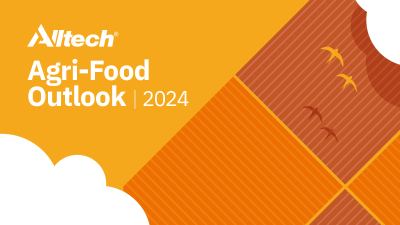Dr. Karl Dawson: Fish 'n' chips: Nutrigenomics in aquaculture

The following is an edited transcript of Tom Martin's interview with Dr. Karl Dawson, co-director of Alltech’s Center for Animal Nutrigenomics and Applied Animal Nutrition. Click below to hear the full interview:
Tom: Over the last 10 years, scientists at Alltech have been using nutrigenomics to develop new feeding strategies and, ultimately, redefine animal nutrition. What are the practical applications of this science, and what does it mean for the future of aquaculture specifically? Joining us to explore these questions and more is Dr. Karl Dawson, vice president and chief scientific officer at Alltech. Thanks for being with us, Dr. Dawson.
Karl: It's a pleasure, Tom.
Tom: Let's begin with a fundamental question: What is nutrigenomics, and why is it such a valuable tool?
Karl: Well, nutrigenomics is really one of the new tools or sciences that we can use to evaluate what specific nutrients or the nutrition of an animal, or a human, is doing to the process of gene expression. Today, we're looking at many different tools that are from this molecular-based science. We can use nutrigenomics, which looks at the transcription or expression of genes, and there are other things, for example, like metabolomics, which looks at the ability of a nutrient to influence the metabolites that are developed in the bloodstream. These are different tools that we're using today that give us a much deeper view of what nutrition does in an animal's body.
Tom: In a recent panel discussion, Farming the Future, you said that nutrigenomics is really going to redefine things, if it hasn't already. Can you elaborate on that?
Karl: Yes. We are using nutrigenomics to find new concepts and challenge the nutritional concepts that are out there today. We are just answering such questions as “What does an antioxidant do, what does it do in the animal's body and to improve animal health?” We can find substitutes for the traditional antioxidants that are out there.
We've done other things, for example, like defining trace mineral requirements in animals. We've used nutrigenomics to redefine what we thought was the expected or needed levels of minerals in an animal's diet. Many of these things are changing what we think about in terms of the way a nutrient will interact with the animal, providing for their health and well-being.
Tom: The name of the field, “nutrigenomics,” might lead someone to believe that it's limited to exploring how nutrition influences the expression of individual genes. But it's more than that, isn't it?
Karl: Yes. Well, nutrigenomics is really built around the nutrition concept — that's the nutrient or nutrigenomics part of it. The term that's probably more appropriate is the term “transcriptomics,” which is measuring gene expression overall. We can look at such things as the effects of a disease process on gene expression, or how a change in environmental temperature affects gene expression. All of these factors influence gene expression; nutrigenomics is just focusing on what the nutrients in the animals’ diets are doing.
Tom: Okay. Let's turn our nutrigenomics focus over to aquaculture. How is this tool being used to define new feeding strategies for fish?
Karl: Well, we have lots of examples of things that we're doing today. Nutrigenomics — or this gene expression measurement — is something that is fairly new in fish, but it is becoming a very popular tool. In the last seven or eight years, there's been a surge of scientific interest in looking at gene expression and what influences gene expression. We've been particularly interested in looking at such things as “How does nutrition influence fillet quality from a fish?” We can identify the specific gene markers that are correlated with such things as the firmness of a fish fillet. Those things are highly correlated. Now, that's very interesting because that's not something we've been able to do in the past — to go in and find specific markers. That doesn't mean the fish does not have those genes. It means it does not have the ability necessarily to express those genes. So, it's not just genetics here. We're talking about the way genes are turned on and turned off.
We've used this very specifically in recent months, or in the last two years, to look at some very specific feed additives that we might use in salmon diets. One of the big problems for the salmon industry today is the problem with sea lice. We've come up with ways to influence the infestation of fish with these sea lice by changing what those fish are receiving. We did that by taking specific feed materials that we had identified and had some history with, and we looked at how they influence gene expression. We tried to find feed materials that would enhance things such as mucin production on the surface of the fish and the innate immunity of the fish. That gave us a lot of clues before we had to do any real animal experimentation to find materials that were very effective.
Tom: Are these salmon now better able to resist sea lice?
Karl: That's the point we've made in the last six months or so. We do have some fish that, while they will still be infested, the infestation rate tends to be much lower. So, if we look at the number of fish that have fewer than 20 lice, for example, we'll see that we can change that distribution and find a lot more fish that have fewer lice. It's not a total resistance to infestation, but it changes the ability of the fish to support this parasite.
Tom: How long does it take for a sample from the herd, the flock or the school, in this case, to yield useful data?
Karl: This is usually a fairly quick thing. Typically, we look for gene expression changes within a matter of days. It can be within a matter of hours. One of the most interesting studies we reviewed just recently was one where we looked at how the sea lice themselves influence the gene expression in the fish. It's very interesting to see, but within three days, those sea lice would change the immunity of those fish, and it’s not by increasing it — they tend to depress it.
They also depress such things as the ability of the fish to respond to wounds and wound-healing mechanisms. This is a very unique observation because we're actually saying that this lice — or this louse — is changing the ability of that fish to recover and is influencing the fish gene expression just by attaching to the fish.
Tom: What are some specific ways aquaculture producers can use the information that you're gleaning from this nutrigenomics research?
Karl: Well, we know quite a bit about specific nutrients today. For example, mineral supplementation is one that we have worked with quite a bit. We do know that if you provide selenium in a very rich organic form such as selenium yeast, you can change the genes, or the expression of genes, that result in immunity and such things as mucin production on the surface of fish.
Those are things that are real, that are being used today, but probably not attributed directly to nutrigenomics. We don't go out and measure the gene response. But, as a result of what we know from gene expression, we can predict what's going to happen in the animal. We can do that quickly, too, because our turnaround time on understanding gene responses is a matter of days instead of waiting for a full production cycle.
Tom: So, it's fair to say that this science is really bringing a new level of precision.
Karl: Right, absolutely.
Tom: What are some new commercially useful feeding concepts that have come directly from the use of this molecular tool?
Karl: Well, as I indicated, minerals are one that is very much being used today — sources and types of minerals that are being used and actual levels of minerals. Mineral supplementation is a common one. We're doing quite a bit of research right now using yeast cell wall components to address what's happening within the fish in terms of disease resistance and, most recently, in terms of nutrient absorption. It appears these materials are also influencing the tight junction proteins that make up the intestinal tract and change the way the fish absorbs its nutrients.
Those are real things that are happening today that will change how we think about providing nutrition to fish.
Tom: Can this tool be used to quickly determine the value of newly developed feed supplements, and how?
Karl: Yes. That's really the approach we use right now. One of the interesting models that we're using today is nutrient injection. If we want to test out a new product or nutrient, we can inject the fish with small amounts of that material and evaluate what's happening with gene expression.
As we do this more and more, we're building a pattern, or an encyclopedia, of responses that we would like to see. We've already done that to some extent with some of our yeast products and some of our minerals. So, we're starting to understand what those responses have to be to speed up the time it takes to evaluate new nutrient concepts.
Tom: How will the tool be used to demonstrate the effects of maternal nutrition on the growth, development and disease resistance of offspring?
Karl: That's getting into another term, “epigenetics,” the concept of being able to pass on traits that aren't really related to the actual genetic material. We don't have a lot of experience in fish. Although we know that a healthier mother tends to have healthier offspring in fish, we've never been able to measure that directly. However, in some of the other livestock species we're working with, it is a very important tool.
One of the observations we've made in pigs, for example, is that by feeding a mother a very specific prebiotic late in pregnancy, we can completely change the gene expression in a young piglet, even at weaning. This is after the pig is quite developed. You're working with a new piglet that has a completely different nutritional set of requirements — it is something totally different.
It is something that we're using a lot more in livestock species than aquaculture species, although we have some ideas in the next couple of years that we're going to try out and see how we can make that work in fish.
Tom: Dr. Karl Dawson directs activities at Alltech’s bioscience centers around the world, including the Alltech Center for Animal Nutrigenomics and Applied Animal Nutrition, where he is the co-director. Thank you for being with us.
Karl: Thank you.
Dr. Karl Dawson spoke at ONE: The Alltech Ideas Conference. Click below to view presentations from ONE18:
















